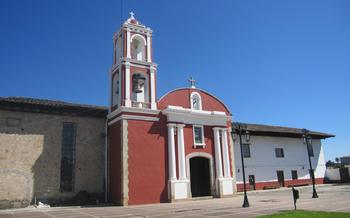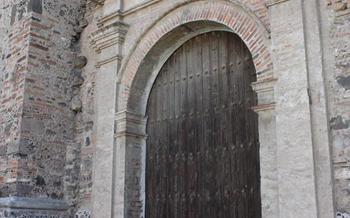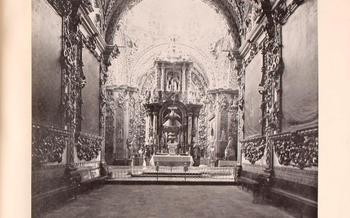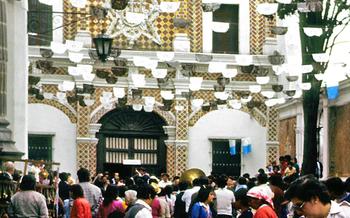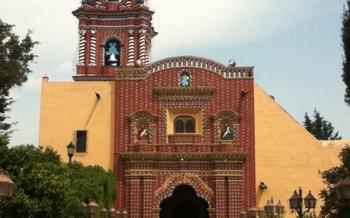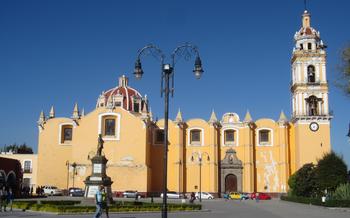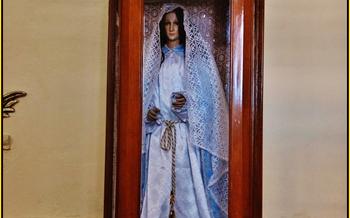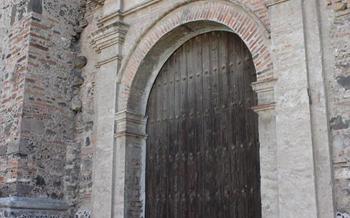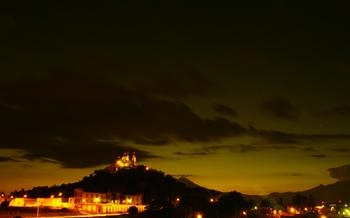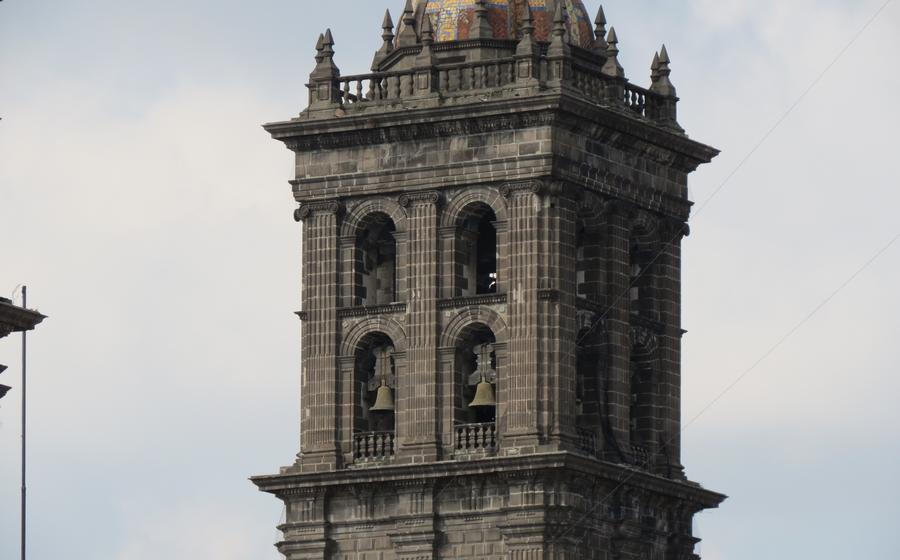
Museo Amparo
- Historical Significance
- Delving into the Past: Exploring the Museum's History
- Unveiling the Architectural Masterpiece
- Highlights of the Permanent Collection
- Temporary Exhibitions: A Window into Contemporary Art
- Interactive Displays: Engaging with Art and History
- Multimedia Presentations: Bringing History to Life
- Visitor Information: Planning Your Visit
- Guided Tours: Unveiling Hidden Treasures
- Museum Shop: Unique Souvenirs and Gifts
- Café: A Culinary Journey
- Educational Programs: Nurturing Creativity
- Accessibility for All: Ensuring Inclusivity
- Sustainability Initiatives: Preserving Heritage
Historical Significance
Nestled in the heart of Puebla, Mexico, the artistic legacy. Founded in 1991 by the Amparo Foundation, the museum is housed in a magnificently restored 18th-century mansion, blending colonial grandeur with contemporary elegance. With its extensive collection spanning pre-Hispanic artifacts, colonial masterpieces, and modern and contemporary works of art, the Museo Amparo offers a comprehensive journey through the artistic expressions that have shaped Mexico's vibrant cultural identity.
Delving into the Past: Exploring the Museum's History
The Museo Amparo boasts a diverse collection of artifacts and artworks that span from pre-Hispanic times to the present day, offering a comprehensive journey through Mexico's rich cultural heritage. Pre-Hispanic artifacts, including intricate sculptures, pottery, and jewelry, provide a glimpse into the civilizations that thrived in this region before the arrival of the Spanish. Colonial art, with its fusion of European and indigenous influences, showcases the artistic expressions of the colonial period. Modern and contemporary pieces, by renowned Mexican and international artists, reflect the dynamic and ever-evolving landscape of contemporary art. Temporary exhibitions, showcasing emerging and established artists, add a fresh perspective to the museum's offerings, ensuring a vibrant and ever-changing cultural experience.
Unveiling the Architectural Masterpiece
The Museo Amparo boasts a unique blend of colonial and modern architectural styles, creating a harmonious fusion of the past and present. The building's facade, dating back to the 18th century, features intricate stone carvings and a grand entrance. Stepping inside, visitors are greeted by a serene courtyard adorned with a fountain and lush greenery, providing a tranquil oasis amidst the bustling city.
The museum's modern wing, designed by renowned Mexican architect Enrique Norten, seamlessly integrates with the historical structure. Its clean lines and minimalist design create a striking contrast while respecting the building's original character. The spacious galleries offer ample natural light, highlighting the vibrant colors and intricate details of the artworks on display.
A highlight of the museum's architecture is the rooftop terrace, which offers panoramic views of Puebla's historic center and the surrounding mountains. This vantage point allows visitors to appreciate the city's rich architectural heritage and its vibrant contemporary skyline.
Throughout the museum, interactive displays and multimedia presentations complement the architectural experience, inviting visitors to engage with the artworks and learn about the museum's history and collections in a dynamic and engaging way.
Highlights of the Permanent Collection
The Museo Amparo boasts a diverse and impressive permanent collection that spans various periods and styles of Mexican and international art. Among the highlights, visitors can marvel at Pablo Picasso's "The Weeping Woman," a poignant depiction of human suffering and despair. Diego Rivera's "The Dance of the Hours" showcases the artist's mastery of color and movement, capturing the vibrant spirit of Mexican folklore. José de Ribera's "The Annunciation" offers a stunning portrayal of the Virgin Mary, rendered with exquisite detail and realism. Caravaggio's "The Entombment of Christ" is a powerful and moving masterpiece that exemplifies the artist's tenebrism technique, creating a dramatic play of light and shadow. These iconic works, along with many others, provide a glimpse into the artistic genius and cultural heritage of Mexico and beyond.
Temporary Exhibitions: A Window into Contemporary Art
The Museo Amparo's temporary exhibitions offer a dynamic and ever-changing window into the world of contemporary art. These exhibitions showcase the works of emerging and established artists, both from Mexico and abroad, across a diverse range of mediums and styles. Curated with a focus on specific themes and concepts, these exhibitions provide visitors with a unique opportunity to engage with cutting-edge artistic practices and explore new perspectives on art and culture. Interactive workshops and artist talks further enhance the experience, allowing visitors to delve deeper into the creative process and connect with the artists themselves.
Interactive Displays: Engaging with Art and History
The Museo Amparo offers a wide range of interactive displays that enhance the visitor experience and make learning about art and history fun and engaging. Touchscreens with in-depth information provide visitors with additional insights into the museum's collection. Audio guides in multiple languages allow visitors to explore the museum at their own pace and in their preferred language. Virtual reality experiences transport visitors to different time periods and allow them to immerse themselves in the world of the artists. Hands-on activities for children, such as art workshops and scavenger hunts, help them learn about art while having fun. These interactive elements make the Museo Amparo an ideal destination for visitors of all ages and interests.
Multimedia Presentations: Bringing History to Life
The Museo Amparo brings history to life through a range of engaging multimedia presentations. Short films delve into the stories behind the museum's collection, showcasing the artistry, symbolism, and historical significance of each piece. Documentaries immerse visitors in the rich tapestry of Mexican art and culture, exploring the lives and works of renowned artists, the evolution of artistic movements, and the cultural influences that have shaped Mexico's artistic identity. Interactive timelines and maps allow visitors to trace the development of Mexican art and history, while virtual tours offer a immersive journey through the museum's galleries, providing in-depth insights into the collection. These multimedia presentations captivate visitors of all ages, transforming the museum into a vibrant and dynamic space where art and history come alive.
Visitor Information: Planning Your Visit
Museo Amparo is conveniently located in the heart of Puebla's historic center. It is easily accessible by public transportation, with several bus routes stopping nearby. For those driving, there are limited parking spaces available in the vicinity. Admission fees are reasonable, with discounts for students, seniors, and children. The museum offers free admission on Sundays, making it an excellent opportunity for budget-conscious travelers. Hours of operation are from Tuesday to Sunday, with extended hours on Fridays. Guided tours are available in multiple languages at specific times throughout the day. The museum is committed to accessibility, with wheelchair-accessible ramps and elevators, audio guides and signage in multiple languages, and tactile exhibits and sensory experiences for visitors with disabilities. Braille and large-print materials are also available upon request.
Guided Tours: Unveiling Hidden Treasures
To truly delve into the depths of the Museo Amparo's collection and uncover its hidden gems, consider embarking on a guided tour. Knowledgeable and passionate guides will lead you through the galleries, shedding light on the historical context, artistic techniques, and symbolism behind the masterpieces.
Thematic tours offer a focused exploration of specific periods or artists, allowing you to gain a deeper understanding of Mexican art and its evolution. Private tours are available for groups or individuals seeking a tailored experience, where the guide can customize the itinerary based on your interests.
Advance booking is recommended to secure your spot, especially during peak tourist season. Guided tours are an excellent way to make the most of your visit to the Museo Amparo, ensuring that you leave with a newfound appreciation for Mexican art and its rich history.
Museum Shop: Unique Souvenirs and Gifts
As you exit the museum's galleries, don't miss the opportunity to visit the well-curated museum shop. This treasure trove offers a diverse selection of art books, prints, and postcards, allowing you to take a piece of the museum's collection home with you. Browse through traditional Mexican crafts and souvenirs, each item imbued with the vibrant colors and rich cultural heritage of the region. Discover exquisite jewelry and accessories inspired by the museum's masterpieces, adding a touch of artistic flair to your wardrobe. Keep an eye out for exclusive merchandise and limited editions, perfect for collectors and art enthusiasts. Whether you're seeking a meaningful souvenir or a thoughtful gift for a loved one, the Museo Amparo's museum shop is sure to delight and inspire.
Café: A Culinary Journey
Indulge in a delectable culinary journey at the Museo Amparo's café. Nestled within the museum's serene courtyard, the café offers a delightful menu that blends Mexican and international flavors. Savor the aromatic coffee and freshly baked pastries as you soak in the tranquil ambiance of the courtyard. Choose from a variety of indoor and outdoor seating options, allowing you to bask in the warmth of the Mexican sun or immerse yourself in the lush greenery. The café also boasts a selection of light snacks and seasonal specials, ensuring that every visit offers a unique and satisfying culinary experience.
Educational Programs: Nurturing Creativity
The Museo Amparo extends its reach beyond its walls through a diverse range of educational programs that cater to all ages and interests. Aspiring artists, art enthusiasts, and lifelong learners alike can find opportunities to immerse themselves in the world of art. Workshops and classes for adults and children offer hands-on experiences, allowing participants to unleash their creativity and explore various artistic techniques. Art history lectures and seminars delve into the depths of Mexican and international art movements, shedding light on the stories behind the masterpieces.
Summer camps provide a fun and enriching experience for children, combining art education with recreational activities. School programs tailored to different grade levels bring the museum's collection to life for young learners, fostering their appreciation for art and history. Outreach initiatives extend the museum's educational mission to underserved communities, ensuring that everyone has the opportunity to engage with art and culture. Through these programs, the Museo Amparo serves as a catalyst for creativity, nurturing the next generation of artists and fostering a lifelong love for the arts.
Accessibility for All: Ensuring Inclusivity
The Museo Amparo is committed to providing an inclusive and welcoming environment for all visitors, regardless of their abilities or disabilities. The museum features a range of accessibility features to ensure that everyone can enjoy and appreciate the museum's offerings.
Wheelchair-accessible ramps and elevators make it easy for visitors with limited mobility to navigate the museum's galleries and spaces. Audio guides and signage are available in multiple languages, including English, Spanish, and French, to accommodate visitors from diverse linguistic backgrounds.
For visitors with visual impairments, the museum offers tactile exhibits and sensory experiences that allow them to engage with the artwork through touch, smell, and sound. Braille and large-print materials are also available to provide additional information and context.
The Museo Amparo is a truly inclusive space that welcomes and accommodates visitors of all abilities. With its commitment to accessibility, the museum ensures that everyone can have a meaningful and enriching experience while exploring the wonders of Mexican art and culture.
Sustainability Initiatives: Preserving Heritage
Museo Amparo is committed to preserving its cultural heritage while embracing sustainable practices. The museum has adopted green building practices and energy-efficient systems to minimize its environmental impact. Recycling and waste reduction programs are in place to promote responsible resource management. Furthermore, Museo Amparo actively engages in community outreach and educational initiatives, raising awareness about the importance of cultural preservation and environmental sustainability. Through collaboration with local organizations, the museum supports conservation efforts and promotes a sense of shared responsibility for the protection of Mexico's cultural and natural heritage.
